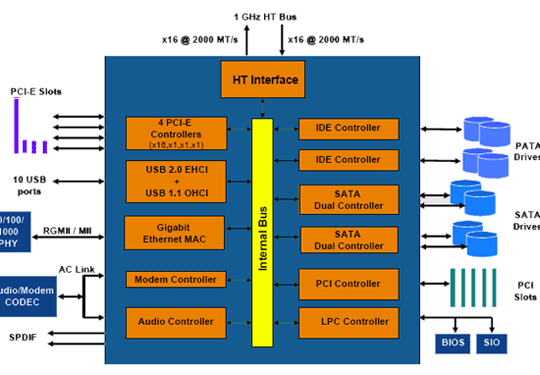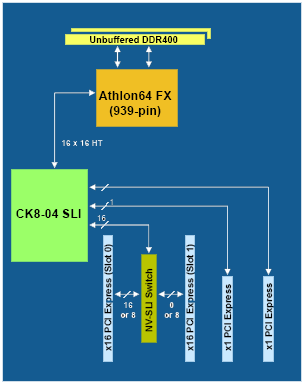NVIDIA's CK8-04; The Best K8 MCP (On Paper)
by Kristopher Kubicki on August 20, 2004 3:50 AM EST- Posted in
- CPUs
We have had very extensive coverage on PCIe solutions from VIA and SiS, and today we complete the circle with some in depth information from NVIDIA's CK8-04; a chipset many have already decided to call nForce4. NVIDIA takes a firm stance in its roadmaps that this next revision of core logic will not use the nForce4 misnomer, so we will continue to call it CK8-04 until NVIDIA calls it something else. We first saw CK8-04 at Computex in June - and even then it supported dual PEG adaptors.
As expected, CrushedK8-04 will come in three flavors, CK8-04 SLI, CK8-04 Ultra and CK8-04. The Ultra and SLI chipsets are simply improvements upon one another, with the SLI chipset being the highest end solution. Vanilla flavored CK8-04 is very much the same as nForce3 250Gb, with the addition of 7.1 high definition audio and PCI Express. We also get four SATA 150 ports. RAID, 10 USB ports. Gigabit Ethernet and a hardware firewall.

The Ultra revision makes things a little more interesting; offering SATA 3Gb/s and an obscure device called the Secure Networking Processor. NVIDIA claims the "processor" enhances networking security, reduces CPU overhead and contains specialized features that defend against hacker attacks. Although we will have to see it to believe it, this journalist suspects it is probably nothing more than a tweaked ruleset for QoS and *maybe* some denial of service protection (hopefully outbound as well as inbound).
Finally, the SLI version of CK8-04 ties everything together with an additional switching PEG solution. Even though the CK8-04 only supports 20 PCIe lanes, NVIDIA's elegant graphic solution runs 16 lanes into what appears to be a separate switching bridge chip. This bridge can be electrically configured to either run all 16 lanes to one PEG interface, or 8 lanes to two PEG interfaces. Remember, PCIe supports 250MBps per lane, so as long as the video card can electrically support itself on 8 lanes, the theoretical 2GBps (full duplex) per video card of a dual x8 configuration is more than enough for upcoming video card solutions for many revisions to come. Current 8X AGP solutions run at 2.1GBps (half duplex) video bandwidth without coming in reach of taxing out the bus.

NVIDIA makes note in the roadmap that the Ultra and Non-Ultra revisions will only support single CPUs. We can only assume the SLI version will not widely be marketed for multiple Opterons, but it sure would be nice to give AMD and VIA some competition in that field. Samples of the new cores are shipping now and should launch early September. In reality, we probably won't see working cores for a few weeks still, but definitely expect to see boards on the shelves before Q3 is out.










47 Comments
View All Comments
themelon - Friday, August 20, 2004 - link
I can confirm that the Ultra will infact support more than 1 Opteron. Infact I believe it will support up to 16.mino - Friday, August 20, 2004 - link
bunbers ... LOLActually k(ilo), M(ega),G(iga), T(era) should ALWAYS be written the way a did in this sentence, since they are from SI-units convention about metric measurements.
B(Byte) should be as far as I know ALWAYS in capital to avoid misinterpretation with b(bit).
However in recent years I frequently see "b" meaning bytes and in the same article "b" meaning bits. It is usually caused by people who are lacking even basic education about computer science. Also they are in many cases wery skilfull in hardware topic, they lack some theoretical background.
Please excuse my grammar since I'm Slovak and I hated English classes during my high school;)
johnsonx - Friday, August 20, 2004 - link
to mino,yeah, I was thinking when I read that "no way does a SINGLE PCIe lane have as much bandwidth as 8x AGP". I didn't have the exact numbers in my head, but I was thinking that 8x PCIe and 8x AGP have about the same bandwidth, and you've shown that to be correct.
At one time, I think the convention was that when abreviating computer capacities and speeds, a small leading letter (i.e. kbps, mbps, gbps) meant bits, while a capital leading letter (i.e. Kbps, Mbps, Gbps) meant bytes. Now I often see the 'B' itself small or capital to denote bits and bytes, which is more intuitive I admit, but I don't think that's correct. That said, to be on the safe side I often use all letters small for bits (i.e. gbps) and the first two capital for bytes (i.e. GBps).
BTW, I knew it was a typo, but I thought 'bunbers' was actually kind of appropriate. New definition:
bunbers = bungled numbers
mino - Friday, August 20, 2004 - link
#3 some minor correction:Therefore your conclusion that SLI PCI-E cards will not be limitted by PEGx8 in bandwidth are correct, but Your numbers presented are COMPLETELY wrong !
sorry for little typo ;) we're all human...
mino - Friday, August 20, 2004 - link
Kris: You stated for instance:"8X AGP solutions run at 2.1Gbps ..."
Which is definitely wrong since AGP supports 32bit*66MHz*8transfers/s = 17066 Mbps which accounts to 2.1GB(bytes)ps or 17.1Gb(bits)ps if you like bits.
All numbers are HALF-duplex naturally.
PCIE supports 2Gbps per lane FULL duplex which is 250MBps and your 2.5Gbps is again out of reality.
16xPEG means 4GBps(GigaBytepersecond) FULL DUPLEX
8xPEG means 2GBps FULL DUPLEX
and APG8x means 2GBps HALF DUPLEX
Therefore your conclusion that PCI-E cards will not be limitted ina bandwith ai correct, but Your bunbers are COMPLETELY wrong !
Kris please correct your nubers as qiuckly as possible to avoid misinterpretation amog your less informmed readers.
Best regards.
thatsright - Friday, August 20, 2004 - link
Uhh, and when would we actully see retail boards based on this chipset. The article left this a bit unclear.Reflex - Friday, August 20, 2004 - link
This is closer to what I am looking for, although I would have liked to see more PCIe lanes, or even a complete removal of standard PCI slots....